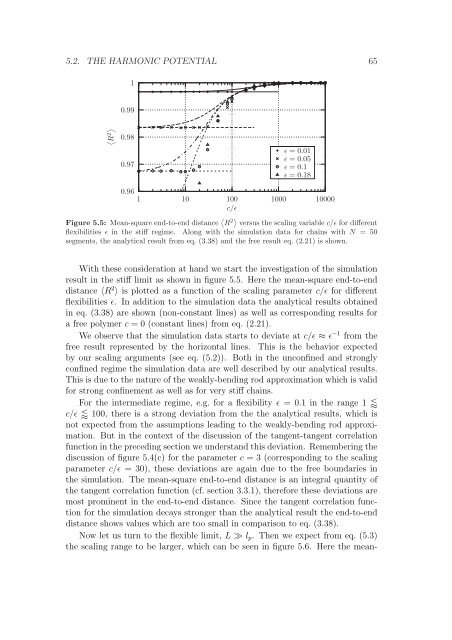Polymers in Confined Geometry.pdf
Polymers in Confined Geometry.pdf
Polymers in Confined Geometry.pdf
Create successful ePaper yourself
Turn your PDF publications into a flip-book with our unique Google optimized e-Paper software.
5.2. THE HARMONIC POTENTIAL 65<br />
R 2 <br />
1<br />
0.99<br />
0.98<br />
0.97<br />
0.96<br />
1<br />
10<br />
100<br />
c/ɛ<br />
1000<br />
ɛ = 0.01<br />
ɛ = 0.05<br />
ɛ = 0.1<br />
ɛ = 0.18<br />
10000<br />
Figure 5.5: Mean-square end-to-end distance R 2 versus the scal<strong>in</strong>g variable c/ɛ for different<br />
flexibilities ɛ <strong>in</strong> the stiff regime. Along with the simulation data for cha<strong>in</strong>s with N = 50<br />
segments, the analytical result from eq. (3.38) and the free result eq. (2.21) is shown.<br />
With these consideration at hand we start the <strong>in</strong>vestigation of the simulation<br />
result <strong>in</strong> the stiff limit as shown <strong>in</strong> figure 5.5. Here the mean-square end-to-end<br />
distance 〈R 2 〉 is plotted as a function of the scal<strong>in</strong>g parameter c/ɛ for different<br />
flexibilities ɛ. In addition to the simulation data the analytical results obta<strong>in</strong>ed<br />
<strong>in</strong> eq. (3.38) are shown (non-constant l<strong>in</strong>es) as well as correspond<strong>in</strong>g results for<br />
a free polymer c = 0 (constant l<strong>in</strong>es) from eq. (2.21).<br />
We observe that the simulation data starts to deviate at c/ɛ ≈ ɛ −1 from the<br />
free result represented by the horizontal l<strong>in</strong>es. This is the behavior expected<br />
by our scal<strong>in</strong>g arguments (see eq. (5.2)). Both <strong>in</strong> the unconf<strong>in</strong>ed and strongly<br />
conf<strong>in</strong>ed regime the simulation data are well described by our analytical results.<br />
This is due to the nature of the weakly-bend<strong>in</strong>g rod approximation which is valid<br />
for strong conf<strong>in</strong>ement as well as for very stiff cha<strong>in</strong>s.<br />
For the <strong>in</strong>termediate regime, e.g. for a flexibility ɛ = 0.1 <strong>in</strong> the range 1 <br />
c/ɛ 100, there is a strong deviation from the the analytical results, which is<br />
not expected from the assumptions lead<strong>in</strong>g to the weakly-bend<strong>in</strong>g rod approximation.<br />
But <strong>in</strong> the context of the discussion of the tangent-tangent correlation<br />
function <strong>in</strong> the preced<strong>in</strong>g section we understand this deviation. Remember<strong>in</strong>g the<br />
discussion of figure 5.4(c) for the parameter c = 3 (correspond<strong>in</strong>g to the scal<strong>in</strong>g<br />
parameter c/ɛ = 30), these deviations are aga<strong>in</strong> due to the free boundaries <strong>in</strong><br />
the simulation. The mean-square end-to-end distance is an <strong>in</strong>tegral quantity of<br />
the tangent correlation function (cf. section 3.3.1), therefore these deviations are<br />
most prom<strong>in</strong>ent <strong>in</strong> the end-to-end distance. S<strong>in</strong>ce the tangent correlation function<br />
for the simulation decays stronger than the analytical result the end-to-end<br />
distance shows values which are too small <strong>in</strong> comparison to eq. (3.38).<br />
Now let us turn to the flexible limit, L ≫ lp. Then we expect from eq. (5.3)<br />
the scal<strong>in</strong>g range to be larger, which can be seen <strong>in</strong> figure 5.6. Here the mean-













